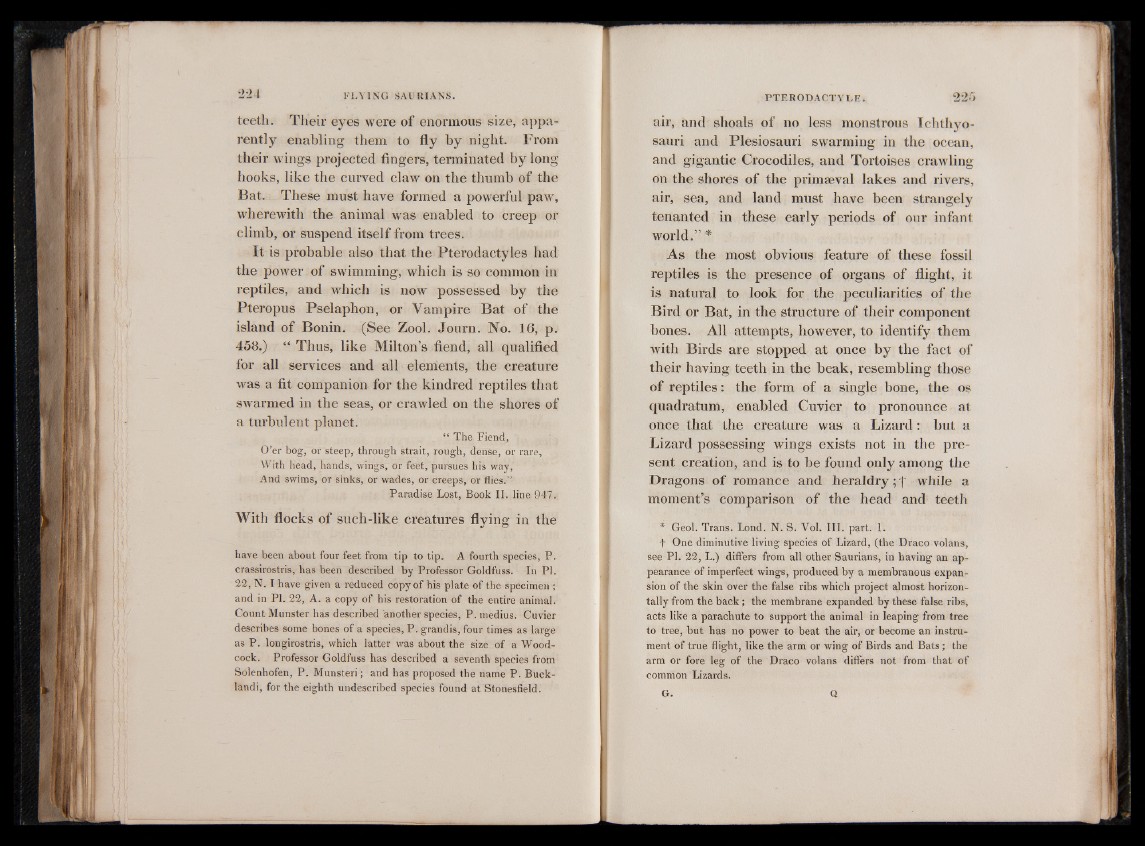
teeth. Their eyes were of enormous size, apparently
enabling them to fly by night. From
their wings projected fingers, terminated by long
hooks, like the curved claw on the thumb of the
Bat. These must have formed a powerful paw,
wherewith the animal was enabled to creep or
climb, or suspend itself from trees.
It is probable also that the Pterodactyles had
the power of swimming, which is so common in
reptiles, and which is now possessed by the
Pteropus Pselaphon, or Vampire Bat of the
island of Bonin. (See Zool. Journ. No. 16, p.
458.) “ Thus, like Milton’s fiend, all qualified
for all services and all elements, the creature
wras a fit companion for the kindred reptiles that
swarmed in the seas, or crawled on the shores of
a turbulent planet.
“ The Fiend,
O’er bog, or steep, through strait, rough, dense, or rare,
With head, hands, wings, or feet, pursues his way,
And swims, or sinks, or wades, or creeps, or flies.”
Paradise Lost, Book II. line 947.
With flocks of such-like creatures flying in the
have been about four feet from tip to tip. A fourth species, P.
crassirostris, has been described by Professor Goldfuss. In PI.
22, N. I have given a reduced copy of his plate of the specimen ;
and in PI. 22, A. a copy of his restoration of the entire animal.
Count Munster has described another species, P. medius. Cuvier
describes some bones of a species, P. grandis, four times as large
as P. longirostris, which latter was about the size of a Woodcock.
Professor Goldfuss has described a seventh species from
Solenhofen, P. Munsteri; and has proposed the name P. Buck-
landi, for the eighth undescribed species found at Stonesfield.
air, and shoals of no less monstrous Ichthyosauri
and Plesiosauri swarming in the ocean,
and gigantic Crocodiles, and Tortoises crawling
on the shores of the primaeval lakes and rivers,
air, sea, and land must have been strangely
tenanted in these early periods of our infant
world.” *
As the most obvious feature of these fossil
reptiles is the presence of organs of flight, it
is natural to look for the peculiarities of the
Bird or Bat, in the structure of their component
bones. All attempts, however, to identify them
with Birds are stopped at once by the fact of
their having teeth in the beak, resembling those
of reptiles: the form of a single bone, the os
quadra-tum, enabled Cuvier to pronounce at
once that the creature was a Lizard: but a
Lizard possessing wings exists not in the present
creation, and is to be found only among the
Dragons of romance and heraldry; j~ while a
moment’s comparison of the head and teeth
* Geol. Trans. Lond. N. S, Vol. III. part. 1.
t One diminutive living species of Lizard, (the Draco volans,
see PI. 22, L.) differs from all other Saurians, in having an appearance
of imperfect wings, produced by a membranous expansion
of the skin over the false ribs which project almost horizontally
from the back; the membrane expanded by these false ribs,
acts like a parachute to support the animal in leaping from tree
to tree, but has no power to beat the air, or become an instrument
of true flight, like the arm or wing of Birds and Bats ; the
arm or fore leg of the Draco volans differs not from that of
common Lizards.
G. Q